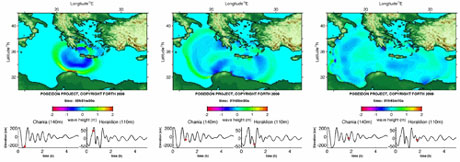by Evangelia T. Flouri, Costas E. Synolakis, Nikos A. Kampanis and Catherine E. Chronaki
The simulation of the extreme destructive historical earthquake of 365 AD in the Aegean Sea will help to draw a realistic disaster scenario to test EU member state collaboration in the frame of the European Civil Protection Mechanism.
POSEIDON, a project co-funded by the European Commission, DG Environment, Civil Protection Unit, aims to design, organize and evaluate an operational civil protection exercise involving Greece, Cyprus and France, addressing the results of a hypothetical extreme disaster caused by an earthquake of considerable magnitude followed by a tsunami. This hypothetical disaster will devastate the island of Crete and will require the invocation of the European Civil Protection Mechanism to bring assistance from other areas in Greece, France and Cyprus. The aims of POSEIDON are: (a) to understand, verify and improve civil protection procedures for preparedness and response, particularly in relation to earthquake events followed by tsunamis, (b) to provide a learning opportunity for the actors involved in civil protection assistance interventions, (c) to test the coordination of EU civil protection assistance particularly through the Monitoring and Information Centre (MIC), and (d) to validate new applications for early warning and communications systems as well as procedures by which to inform the public of emergency measures to be undertaken.
FORTH-IACM, and specifically the Laboratory of Coastal Research & Applications is responsible for performing a risk assessment study that will provide the hypothetical disaster scenario from a large earthquake and the tsunami that follows, using advanced simulation techniques. The risk assessment study involves the production of tsunami inundation and seismic intensity maps to be used before the exercise by the emergency planners to prepare their response and then during the operational exercise when additional local scenarios will be added to overwhelm the local command and control and direct search and rescue operations.
We take as our starting point the historical earthquake of 365 AD that occurred in the sea west of the island of Crete and which was followed by a tsunami. Historical sources report that this particular earthquake caused extensive destruction, and this has been verified by contemporary seismological and geological research (Shaw B, Ambraseys NN, England PC, Eastern Mediterranean tectonics and tsunami hazard inferred from the AD 365 earthquake, Nature Geoscience 1, 268 - 276 (2008) ). Apart from the destruction, the earthquake caused significant geological disturbances, particularly acute in the westward coast of the island.
The reconstruction of the earthquake characteristics from bibliographical information will simulate the movement of the tectonic plates in the rupture area, and will provide the initial conditions for the numerical simulation of the tsunami wave. The software used performs a full simulation of the tsunami wave, that is, its generation, propagation in the open sea, and run-up when it reaches the coast (see article by Evangelia Flouri et al ). The exact bathymetric data around Crete were acquired from the Hydrographic Service of the Hellenic Navy, for the purposes of more realistic modelling.

Figure 1: Snapshots of the propagation of the tsunami generated by the 365 AD earthquake.
FORTH-ICS will be responsible for the deployment and evaluation of information and telecommunication technology in the POSEIDON exercise, emphasizing the emergency deployment of auxiliary satellite and WiFi networks, to support the strained telecommunication infrastructure. Relevant standards such as those proposed by OASIS, W3C and HL7 will also be reviewed and evaluated in the context of the exercise, focusing on the timely provision of information to the public as well as on efficient and effective management of emergency episodes.
Interoperability considerations are key to the POSEIDON project, since one of its main aims is to demonstrate effective cross-border collaboration between France, Greece and Cyprus, possibly identifying issues related to the use of the civil protection modules in the context of the European Civil Protection Mechanism.
FORTH-ICS has been one of the key participants along with Institut de Médecine et de Physiologie Spatiales -MEDES (FR) and Telemedicine Technologies (FR) in Satellites for Epidemiology SAFE, a 2007 civil protection exercise, aiming to demonstrate the value of satellite-enabled applications for early warning in public health following an epidemic outbreak, with the backdrop of a severe earthquake (see article in ERCIM 75). With POSEIDON we move a step forward, as scientific risk assessment based on a historic earthquake disaster is used to create a realistic disaster scenario to test EU member state collaboration in the frame of the European Civil Protection Mechanism.

Civil protection exercise.
The Project is coordinated by Mrs. Koutentaki, Director of Civil Protection in the Region of Crete, Greece. The Civil Defence of Cyprus (Cy), the General Secretariat of Civil Protection (GR), the Hellenic Red Cross (GR), Civil Protection Sans Frontiers (FR), Telemedicine Technologies (FR) and FORTH (GR) are partners in the project. FORTH participates in the POSEIDON project with two of its seven institutes, the Institute of Computer Science (FORTH-ICS) and the Institute of Computational Mathematics (FORTH-IACM).
Links:
Region of Crete, Directorate of Civil Protection: http://www.crete-region.gr
FORTH-Institute of Computer Science: http://www.ics.forth.gr
FORTH-Institute of Computational Mathematics: http://www.iacm.forth.gr
General Secreteriat of Civil protection, Ministry of Citizen Protection, Greece, http://www.gsrt.gr
Civil Defence, Ministry of Interior, Cyprus: http://www.moi.gov.cy/moi/cd/cd.nsf/intro?OpenForm
European Civil Protection: http://ec.europa.eu/environment/civil/
Hellenic Red Cross:
http://www.redcross.gr/
FORTH-IACM, Laboratory of Coastal Research & Applications: http://www.iacm.forth.gr/CFD/CIRU.php
Please contact:
Nikos Kampanis
FORTH-IACM, Greece
E-mail:
Catherine Chronaki
FORTH-ICS, Greece
E-mail:










